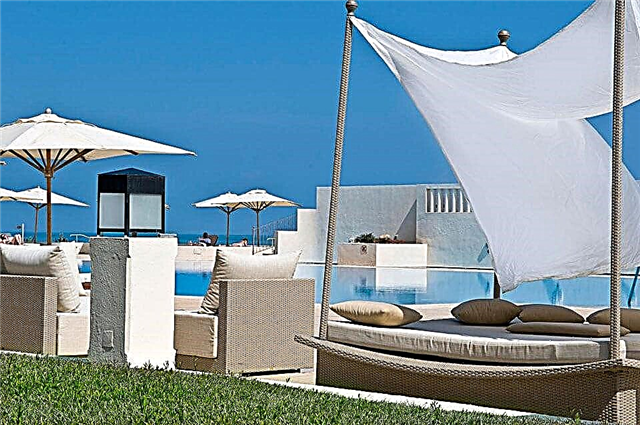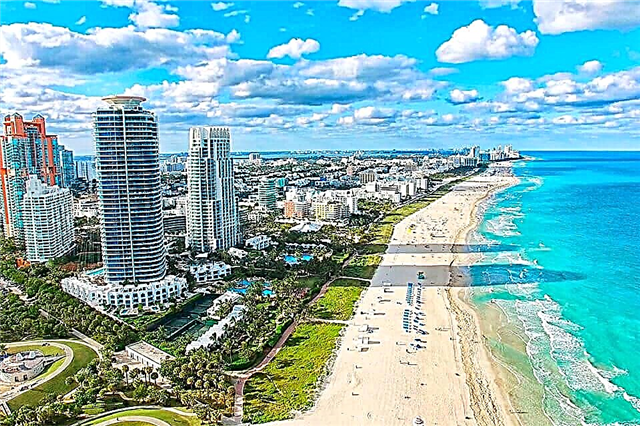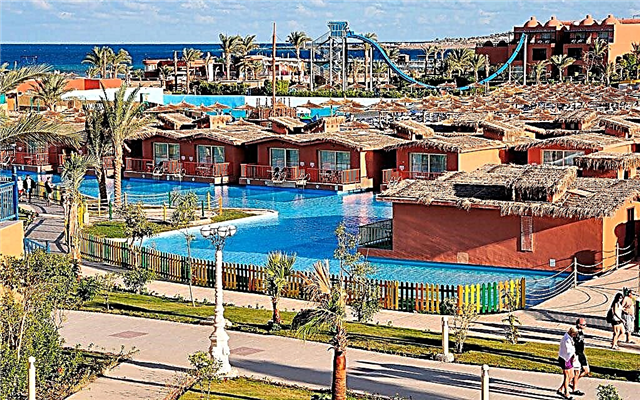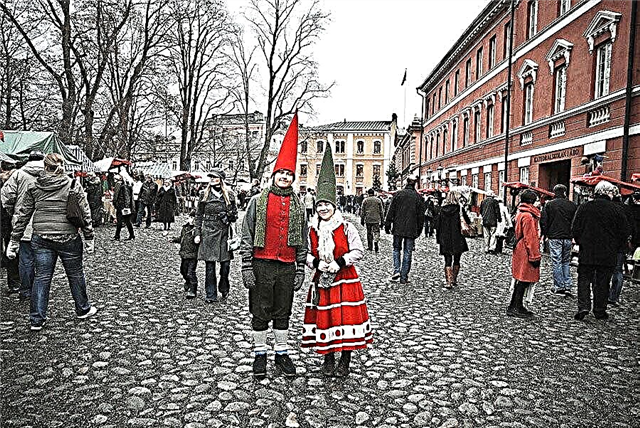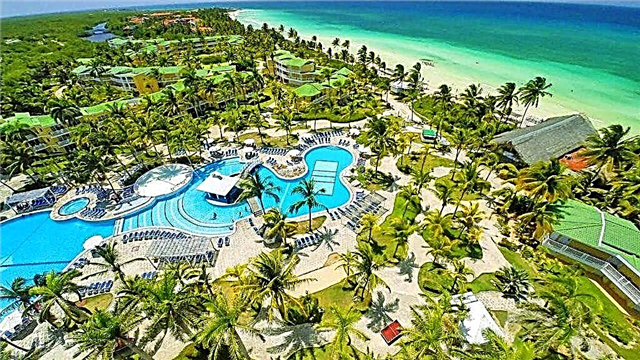It would seem that in a city with a million people it is not so easy to see all its attractions. However, in the capital of Malaysia, most interesting places are concentrated not only within the city, but also in the very center. In addition, many of them can be reached even on foot, and the famous Batu caves, located outside the city limits, can be reached by the convenient metro. Tourists who were lucky enough to get acquainted with the most interesting city of Malaysia - Kuala Lumpur - certainly were able to appreciate all its advantages. It simultaneously combines the advanced achievements of civilization, and carries some kind of unique aura that has survived from ancient times. Here you can meet high-rise buildings aspiring to heaven, visit amazing places and even relax in the shade of landscaped green park areas. Of course, the main attention of many guests of the metropolis is focused on the central Independence Square, but in other parts of the city there is a lot of things that you should definitely see. Let's talk about the most interesting sights of Kuala Lumpur.
Masjid Jameh Mosque

We suggest starting our walk with an acquaintance with the most ancient mosque, which was built in 1909 by the idea of a brilliant native of Great Britain A. Hubback. It is located in a symbolic place where the Klang and Gombak rivers merge. The place was not chosen by chance, because according to the historical information, it was here that the first settlement existed, which was destined to soon become the capital of the state.
For those who understand the directions of architecture, it will be obvious that the building is made in the Moorish style, its color scheme is dominated by red and white tones. The complex includes several towers, minarets and three domes. And the role of the background is played by perennial plantations of coconut palms. It is not surprising that it is here that the remains of the most prominent figures of the city and the country are kept, for whose tombs a considerable area is allotted. For a long time, this particular mosque was the main one throughout the country, until in 1965 the more modern Negara was awarded this honor.
St. Mary's Anglican Cathedral

The second striking reminder of the long presence of colonial Britain in Malaysia is the Cathedral of St. Mary. Erected in 1898, this grandiose cathedral is a true example of the Gothic architecture of the early European island nation. In its features, everything is laconic and there is not a single superfluous detail. This is exactly how, according to the architects, a holy place for communication with God should look like. But the most interesting thing awaits tourists inside. In the center of the hall is the main pride of the cathedral - the old organ, which was created by the recognized genius of his time, Henry Willis, whose inventions adorn the best cathedrals in London.
The interior of the premises is designed in the usual style: the walls are lined with white stone, and the figured windows are decorated with multi-colored stained-glass windows. The rays of the sun passing through them create a unique play of colors and a unique color illusion. It is worth agreeing that the creators managed to achieve the main goal - to create an atmosphere of solemnity and peace. By the way, not so long ago, only the British were allowed into these halls, who were the main participants in the ceremonies of worship. Today, in the cathedral, one can meet parishioners from a wide variety of ethnic classes.
Royal Selangor Golf Club

Not far from the cathedral there is the Royal Selangor golf club, where the British are used to spending their free time after the morning divine service. It's not hard to guess who came up with the idea to create the first golf club in Malaysia. After all, the British have long been famous for their passion for this measured sports competition. In 1893, an advertisement appeared in the newspaper, according to which everyone could take part in the first golf tournament, which was to be held on the local Petaling hill.
As soon as the local rich of English descent hit the ball, it was decided to create the first golf course on this hill. The players liked the mixed terrain and natural water obstacles. Despite the fact that in the early years of its existence, the Royal Selangor club had only a few members and had only one small field in its location, a century later it turned into one of the most prestigious clubs of our time.
Nowadays, on its territory there are already several courses of different sizes for playing golf, tennis courts, swimming pools and gyms and even a real school for studying martial arts! Accordingly, in order to feed the club members and visitors, we had to think over a network of catering establishments. Today, guests and members of the club are served by several restaurants and cafes, where you can taste not only local cuisine, but also appreciate the recognizable recipes of European and Asian cuisine.
Although the club is designed for professional players for whom large-scale competitions are held, beginners will be able to learn club skills and hitting techniques from experienced masters and instructors.
Independence Square

Independence Square was once the usual English cricket ground. Perhaps that is why she received such a name, which seems to "scream" about the cherished freedom that Malaysia received after the departure of the British colonialists. In 1957, the flag of an independent state was raised here for the first time. The Malaysians were so eager to find freedom that to raise the banner they decided to create a huge flagpole, which reaches a height of 95 meters and is a real record holder to this day.
By the way, the most interesting sights of the city are located on the territory of the square, the main of which is the palace of Sultan Abdul-Samad. It was erected back in 1897 by another representative of Great Britain, Arthur Norman. According to sources, the author drew his inspiration from the state of the Great Mughals, who treated their rulers with special trepidation and in every possible way wanted to emphasize their high status by building marvelous palaces for them.
The main decoration of the building is a high chapel, the top of which is decorated with an exquisite gilded dome. The chapel, however, like the cathedral itself, combines two directions in architecture at once - Moorish and Victorian. The author managed to perfectly combine different notes of these directions, and the result exceeded even the most daring expectations. Tourists can spend hours enjoying the marvelous arches, minarets and domes, which are very much like onions in shape.
Not surprisingly, Malaysians compare the chapel to the English Big Ben. Well, if you get into the vicinity of the castle in the evening, you get the impression that you are in a real oriental fairy tale - hundreds of multi-colored lanterns generously shower the walls of the castle and its towers with rays.
Textile Museum

If you love history, be sure to check out the National Textile Museum, where you can trace the entire history of Malaysia. It houses a large collection of samples of fabrics, national clothes, festive and everyday outfits and colorful patterns. It was from these drawings that it was possible to distinguish people who belonged to different class groups.
Visitors to the galleries will learn about the techniques for making fabrics, how and with what techniques patterns were applied to clothes.To make it easier for guests to navigate, the galleries are divided into four main expositions, each of which contains enough information and samples of fabrics, mechanisms that were used in different historical eras. One of the galleries contains thousands of unique jewelry, hairpins and brooches that were typical for different regions of Malaysia.
For the sake of fairness, it is worth noting the very building of the repository of history, which also represents a striking example of neo-Moorish architecture. The façade is lavishly decorated with towers, carved arches and towering spiers.
Batu caves

The Batu Caves are famous for their ancient age, which is about 400 million years old. These natural formations were discovered 200 years ago, and soon one of the Indian traders set about building a temple to the god Muruga near the entrance to the cave. Later, the tallest statue, reaching 43 meters, was erected here, on which about 300 liters of gold paint were spent. In 1920, a staircase of 272 steps was built, leading from the huge statue to the entrance to the main cave.
In addition to the many steps, the staircase is distinguished by a large number of various religious figures and statues that form a kind of sculptural composition. The walls of the caves are also decorated with sculptural deities, and the light penetrating through the natural rift makes it possible to inspect the cave from the inside. In a distant cave at the altar, Hindus often pray, who revere these places and strive to carry out their rituals here. Bats live in one of the Batu caves. Therefore, not everyone is allowed here, so as not to disturb the bats.
Shri Mahamariamman temple

There are many different religious buildings in Kuala Lumpur. Despite the predominance of Islam, representatives of different religious confessions feel great here. In particular, the oldest Hindu temple, Sri Mahamariamman, is the main shrine for Hindus not only in the capital, but throughout Malaysia. The temple was built in the 19th century, when migrant workers from South India began to arrive at the rubber plantations of Malaysia. According to Hindu beliefs, the goddess Mahamariamman protects from disease and provides food.
Therefore, in a foreign land, it became necessary to build a temple, where one could ask his deity for protection and salvation. In 1885, the building was moved to the outskirts of Chinatown and a five-tiered gopuram tower was erected above the entrance to the temple, decorated with colorful sculptures of Hindu deities. This Hindu temple houses a silver chariot with many bells. Every year, on the Taipusam holiday, which falls in January-February, a statue of the god Murugan is erected on a chariot and carried through the streets of the capital, accompanied by an elegant crowd, heading to the Batu caves.
Petronas Towers

Today these are the tallest twin towers in the world. The bases form an eight-pointed star, which symbolizes harmony and unity among Muslims. This architectural symbolism is characteristic of the Islamic state.
The skyscrapers are connected by the "Sky Bridge" at the 41st floor. There is also a magnificent observation deck, from where an excellent panorama of the city opens. In addition to the office space inside the towers, there are exhibition spaces, a theater, art galleries, restaurants and cafes. Every day, the attraction is visited by about 300 people, although there are a lot of people who want to see the city from a bird's eye view, so tickets must be purchased in advance.
Menara Kuala Lumpur TV Tower

Among the high-rise buildings, it is worth noting the Menara Kuala Lumpur TV Tower, which has the fame of the tallest man-made structure in all of Malaysia. The TV tower quickly gained popularity among newlyweds. Here, for young people getting married, they arrange special show programs, photo sessions, and also offer banquet services. The tower is quite legally used by base jumpers for breathtaking parachute jumps.
Even at night, the tower is clearly visible from any part of the city due to the amazingly skillful illumination, nicknamed by the locals "The Garden of Light". Construction of this scale is also an example of respect for the environment. They tried to preserve the centenary tree growing nearby the TV tower during construction work, although it did not come cheap.
Bird park
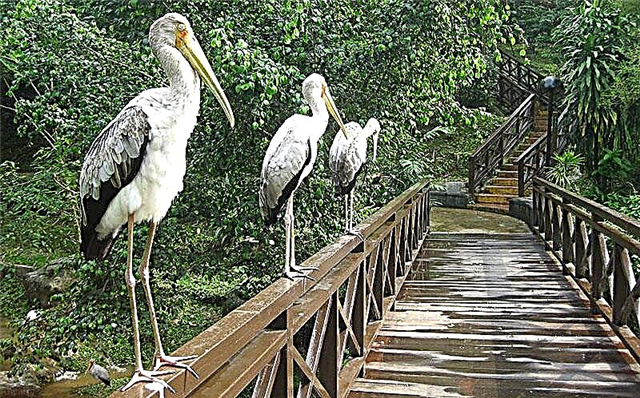
The bird park is one of the most visited by tourists and locals. For more than 3 thousand birds, collected from all over the world, the most comfortable living conditions have been created here. Most of the birds flutter freely among the trees, over which a net is stretched only so that the feathered inhabitants do not fly away from the park. Keeping birds in close natural conditions gives them the opportunity to feel so great that almost all of them regularly give birth to offspring.
Every day visitors to the Bird Park can witness exciting performances with the participation of birds singing, dancing, performing acrobatic stunts and solving mathematical problems. The talented "artists" are parrots and toucans, ostriches and flamingos, storks and peacocks and many other equally gifted inhabitants of this unique bird kingdom. Interestingly, visitors to this abode of birds are not required to adhere to strict rules, but you should not scare the birds and try to feed them yourself.
Istan Negara Royal Palace

The main building of the capital of Malaysia is the official residence of the king. The palace of Istana Negara was built in 1928, after which it was rebuilt and expanded many times. The last restoration was completed in 2011, and now the royal chambers are considered a modern example of functionality and luxury. On the territory of 28 acres there is a swimming pool, a golf course, a park, a lake, a tennis court, picturesque flower beds and a wonderful garden.
The attraction is closed to tourists, but outside the gates you can see the ceremony of changing the guard of honor, which gathers many spectators. The event is rehearsed to the smallest detail, the movements of the participants are verified, and the colorful shape of the times of the British colonization makes it very beautiful.
Central Park

In the midst of glass skyscrapers is a green oasis for relaxation. Its territory is 20 hectares. The park was established in 1980, and a key goal of its organizers was to draw attention to the value of the rainforest. Through the labor of landscape designers, exotic plantings of palm trees, artificial lakes with luxurious fountains, spectacular sculptures, pretty bridges and many paths have appeared here and very harmoniously coexist.
Central Park has a splash pool for young visitors and a playground. The park offers a gorgeous view of the majestic Petronas Towers, which are located very close. It is from this point of the city that one can appreciate their scale and undeniable splendor.
Lake Gardens Park

Lake Gardens gives the impression of isolation and autonomy from civilization. It is the oldest botanical garden in the capital of Malaysia with an area of 90 hectares, its territory is made up of various gardens. Floristic compositions are thought out to the smallest detail and look very impressive. Go to the promenade along the picturesque alleys, and you will forget that you are in a modern metropolis, there is a feeling of complete unity with nature.
The hibiscus garden is a visiting card of Lake Gardens and an incredibly beautiful place. The terraces are home to various types of fancy flowers that are the symbol of Malaysia. In the Orchid Garden, visitors will see over a thousand species of this magnificent plant. Part of the botanical garden is the famous Butterfly Park, which has all the conditions for the habitation and reproduction of spectacular winged beauties.There is also a Bird Park with 3000 inhabitants, which is the largest bird nursery in Southeast Asia. The park also houses the country's largest National Planetarium.
Zoo Negara

Opened to visitors since 1963, Negara covers 110 acres and hosts up to a million guests from all over the world annually. A distinctive feature of the national zoo in Malaysia is that the conditions in which the animals live are as close as possible to their natural habitat. The zoo is divided into thematic zones: the largest - "Savannah" - is home to many characters from the cartoon "The Lion King": antelopes, giraffes, zebras, rhinos and other animals.
Expositions with self-explanatory names also attract many spectators: Parks of Monkeys, Reptiles and Bears, Lake of Birds (for waterfowl) and Aviary, Panda Center, Exhibition of Insects and Aquarium with amazing marine life. A free bus runs through the territory, where you can get to the exhibition of interest.
Negara Mosque

The picturesque complex is considered a symbol of Islam and the spiritual center of the city. The picturesque shrine is open to non-Muslim tourists, but at certain times and subject to the dress code. The main hall of the mosque can accommodate 8,000 people at a time. A ribbed star-shaped dome spreads over the building. It has 18 corners, which is an example of architectural symbolism: the 5 fundamental pillars of Islam and 13 all the states of Malaysia that the religion embraces.
The dome is painted blue and green and looks very colorful. The interior of the temple deserves special attention. The monumental building with colored glass, through which the sun's rays penetrate, is a memorable sight. Nearby there is a snow-white minaret (prayer tower), which is 73 meters high.
Sultan Abdul-Samad building

The visiting card is the palace, built at the end of the 19th century. Its appearance harmoniously combines Victorian and Moorish architectural styles. English restraint is complemented by oriental splendor, which emphasizes the identity and uniqueness of the palace's appearance, which is why the building is popular among travelers.
The building is also called the Kuala Lumpur Big Ben, since a forty-meter clock tower rises in the center of the building. In the evening, the palace lights up and looks like a fairytale castle, so when planning a sunset promenade, plan your route past On New Year's Day or Malaysian Independence Day (August 31), a magnificent parade on a wide scale takes place here.
Oceanarium Aquaria KLSS
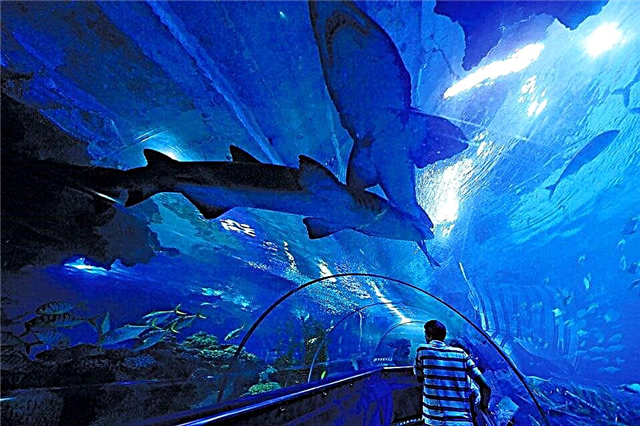
You can observe the life of marine life, of which there are no less than 20 thousand, in the 5.6 sq. M aquarium. Having received a booklet at the checkout, which indicates the feeding schedule, visitors can see how predatory sharks and piranhas, mysterious stingrays and octopuses eat. Here you can touch some inhabitants of the underwater depths, ride in the world's only ninety-meter underwater tunnel, make a portrait of a charming turtle, look at the development of a shark embryo, admire colorful fish and fish of impressive size, catch nimble shrimps and much more.
Every year, a part of the aquarium's expositions changes, so that it would be interesting to come here again and again. Thousands of tourists and locals alike strive to visit this popular family-friendly destination every day, so tickets must be purchased in advance.
Central market

To fully experience the fullness of Malaysian flavor, head to the Central Market. The history of the attraction goes back to 1888, when there was an active trade in seafood, fruits and vegetables. Today, the shopping arcade is filled with souvenirs, clothes and all kinds of hand-made accessories.
Fabrics, jewelery, handmade bags, belts, figurines, tableware, luxurious Indian saris, artwork created by local craftsmen right in front of you, and more can be purchased at Central Market. Even if you do not plan to buy anything, do not pass by a place that fascinates with its originality and ease.
Chinatown

The bustling Chinatown is nestled in the city center. The place is popular with travelers, because here, among thousands of red Chinese lanterns overhead, the aromas of Asian cuisine and brisk vendors, you can feel the atmosphere of crowded China. Chinatown becomes the busiest in the second half of the day: in the middle of the street, another shopping mall "grows". Everything from children's clothing to household appliances is sold in Chinatown.
Many restaurants and cafes offer exotic dishes. The quarter, empty by midnight, becomes no less interesting: it’s just time to take colorful photos against the backdrop of the scenery of the Celestial Empire. The location close to the main attractions makes Chinatown popular among tourists: budget hostels and inexpensive hotels for those who want to save money in excess.
National Museum

The cultural and historical heritage of the Malays from ancient times to the present day is located in the National Museum. The three-story building of the museum is decorated with Italian mosaics and is located on the top of a hill. In four rooms, exhibitions are collected that tell about different periods of history: the prehistoric era, the Malay kingdom, the colonial period and the present day. In the first room, ancient Malaysian finds and wax figures of primitive people are displayed, which makes the exhibition more realistic.
The hall reproduces scenes from the life and life of the Malays before the ships of the Europeans sailed here. Pay attention to the luxurious royal bed, made by the best craftsmen in the country. In the hall of the colonial era, there are many mannequins in national clothes, scenes from the life of local residents and retro vehicles (including the first bicycle, carts, cars of the last century and the first steam locomotives).
Perdana Botanical Garden

Why not be in the jungle without leaving the metropolis? This is exactly the feeling when you walk through the Perdana Garden. Thousands of exotic plants are collected in one place, many specimens have information plates. An amazing African "sausage" - a tree whose fruits are poisonous when raw, trees are neatly trimmed, squirrels scurrying here and there, baobabs, flower beds with all kinds of flowers. Even in bad weather, Perdana's garden is beautiful.
There are sections of the park with a glass roof, you can hide from the rain in a tree house in the middle of thickets of bamboo, or have a picnic there, hiding from the heat. Tropical plantings of African and South American plants are a great place for juicy photos against the backdrop of real floral decorations.
Tian Hou Temple

The most picturesque Buddhist temple in Malaysia rises on a hill near Little India. It is dedicated to the goddess Tian Hou, the patroness of seafarers. The multi-storey shrine is built in the Chinese style, and every detail is magnificent in its own way. It will take a long time to see the figurines, sculptures, wall patterns and secret courtyards.
There is even a lake with turtles and a garden of medicinal plants. Climbing to the highest terrace, visitors to the shrine can appreciate the fantastic panorama of the city that opens from here. Taking off your shoes, you can enter the temple and appreciate its rich interior decoration. At the altar of the goddess, you can tell fortunes, and passing by the well of desires, do not hesitate to make your dreams come true.
Vilayat Persecutuan Mosque

Vilayat Persecutuan is not only a prayer house for Muslims, but also the architectural pride of Kuala Lumpur. The construction of the mosque was completed in 2000.Architects, inspired by the religious structures of the Ottoman and Persian civilizations, recreated an architectural masterpiece. The imposing gray marble building looks impressive. On the sides there are pointed minarets, from where the call to prayer can be heard.
Fountains and palm trees around give the complex a certain charm, and the sky-blue domes-gambizes seem to connect the earthly and heavenly origins. The graceful architectural ensemble reveals the multifaceted Muslim culture. The mosque is allowed to visit non-believers, but subject to the dress code. From the balcony you can watch how the prayer is being performed and preparations for it in the prayer hall.
Museum of Islamic Art

Muslim-inspired art is a fascinating page in Malaysian culture. It is not necessary to practice this religion to appreciate how interesting and beautiful the museum is. The four-story building contains relics related to Islam. Ancient manuscripts in Arabic, ancient manuscripts, a collection of ceramics and Korans, jewelry, legends and even illustrations for them.
In a separate room, beautiful and terrifying weapons are presented. There are many graceful daggers, bayonets, pistols and pistols of the 19th century, helmets and other attributes of jihad. There is an exposition in which models of the most famous mosques in the world are presented. Tiny elements of miniature temples can be viewed for a long time. In the shop you can buy a souvenir to remember the excursion, household items or religious literature.
KidZania Children's Center

If you are traveling with children, do not miss the opportunity to visit KidZania Children's Recreation Center. Here, young visitors will have to learn in a playful way. The KidZania program is aimed at instilling in children the skills of independence, responsibility and the ability to make decisions. On the territory of the center there is a huge number of sites where children master various professions, learn to make independent decisions.
More than 70 scenarios have been prepared for visitors: extinguish a fire, become a chef or pastry chef by preparing an edible dish, a pilot, write an article for a newspaper or broadcast news, be a doctor, artist, supermarket cashier, conduct experiments in a laboratory and many other exciting activities. The guys are paid with the currency of Kinzania, and this is another useful lesson in financial literacy.

